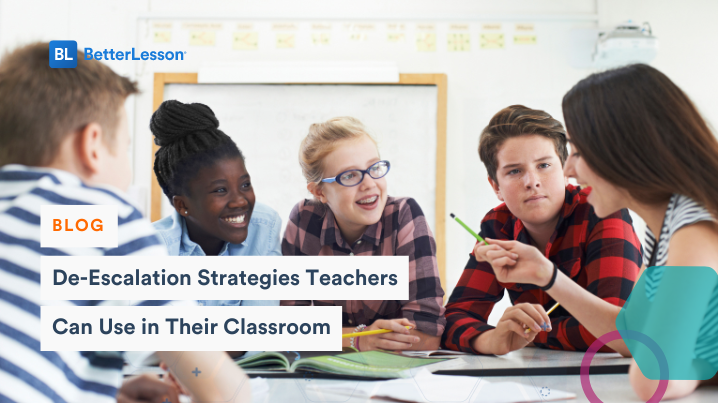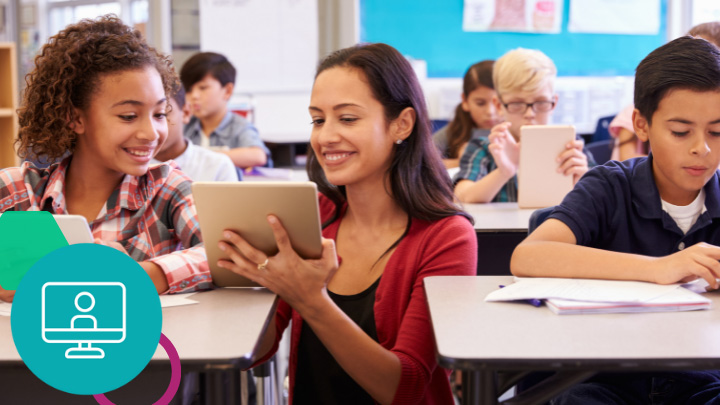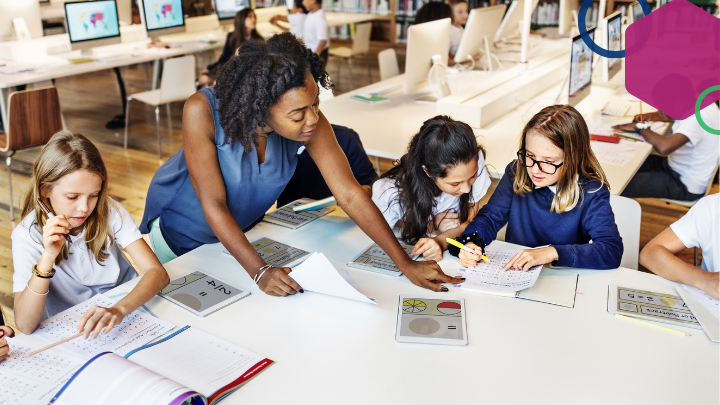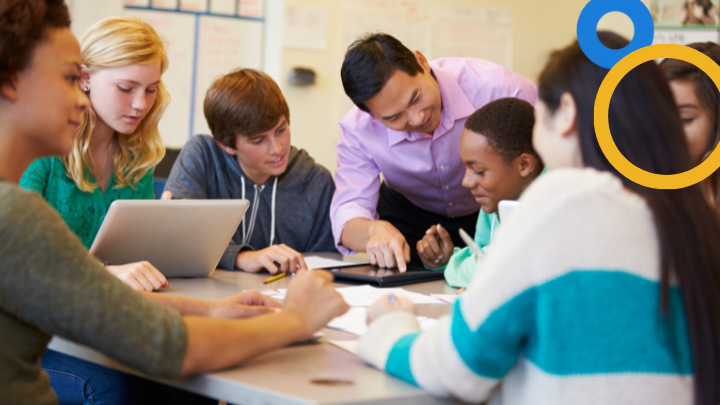Conflict is an unavoidable reality of teaching. Whether it is caused within a classroom or occurs because of outside circumstances, conflict is inevitable. Once school leaders and educators accept this reality, the question isn’t how can we avoid conflict? but instead how can we respond to conflict?
Last year, BetterLesson hosted an interactive webinar on Exploring De-Escalation Strategies and Interventions. In this blog post, we will provide important take-aways and actionable resources to support school leaders and teachers in building out effective de-escalation practices.
Why Is De-Escalation Important?
The COVID-19 pandemic accelerated an already growing crisis: declining student mental health. Since students returned to in-person schooling, there has been a substantive growth in mental health challenges, leading to behaviors like aggression, violence, withdrawal, and self-harm.
This crisis is observed by school leaders and educators across all contexts. In fact, during the webinar, out of the 52 school leader participants, 45% indicated that behavioral issues were on the rise in their districts, with data (i.e. office referrals, disciplinary data, etc.) to prove it. And 43% of the participants indicated a rise in behavioral issues, despite not yet having supportive data. This means that almost 90% of school leaders who participated in the webinar agreed that – whether observationally or through data – teachers are struggling with challenging student behaviors.
On top of this serious student mental health crisis and the challenging behaviors that follow it, there is another crisis: teacher burnout. Similarly, teacher burnout, an issue that has been persistent for years, has been exacerbated by the difficulties of the pandemic.
The combination of these realities – declining student mental health and teacher morale – creates a remarkably challenging landscape for students, educators, and school leaders. How can schools both recognize this challenge with compassion while also providing a path forward that promotes connection and restoration? The practices and strategies associated with de-escalation provide one powerful path toward rebuilding positive, healthy, and productive classrooms.
Understanding Behavior Escalation and De-Escalation
Before diving into the tactics of de-escalation, it is important for educators to interrogate the underlying causes of behavioral issues. Without this understanding, it is easy for educators to conflate behaviors with the whole student. In other words, rather than saying “This student is exhibiting challenging behaviors,” an educator who lacks understanding of root causes of behavioral issues might say, “I have a challenging student.” The behaviors, then, define the student. Instead, when we look into underlying causes, educators can more easily maintain connection with their students and more readily understand effective de-escalation techniques.
While the root causes of behavior are different for every student, here are seven common underlying causes of challenging behaviors that can serve as a starting point:
A student exhibiting challenging behaviors might be…
- Dealing with an upsetting situation
- Coping with sensory issues
- Struggling with a learning disability
- Wanting attention
- Struggling with a mental health condition
- Attempting to impress peers
- Engaging in exploratory risk-taking
When we approach de-escalation through the lens of underlying causes, we avoid the trap of taking student behavior personally, and instead, we create the capacity to respond with empathy and understanding.
Seven Phases of Behavior Escalation
The seven phases of behavior escalation, coined by Dr. Geoffrey Colvin and George Sugai, explains the typical progression of how behavior escalation occurs.
- Calm: Student is calm, cooperative, and focused.
- Trigger: Something – either in the classroom or in their personal, outside lives – provokes escalation in student behavior.
- Agitation: Student is increasingly unfocused, upset, and avoidant.
- Acceleration: Student becomes solely focused on unresolved issue, non-compliant.
- Peak: Student loses the ability to think rationally, may exhibit severe (violence, aggression, etc.) behavior.
- De-Escalation: Severity begins to subside. Student’s energy level drops.
- Recovery: Student may experience regret, sorrow, shame.
It is important to understand that there are two sides to these phases: As the student’s behavior escalates, the teacher’s behavior can escalate, too. This is where these phases can become accelerated, the student’s and teacher’s behavior escalations contributing to one another’s emotional dysregulation.
Instead, it is critical during moments of behavior escalation for teachers to attend to their own emotional regulation before responding to the student. This allows the teacher to respond in a calm, empathetic manner, which both helps to de-escalate the student and to center connection and repair during the Recovery phase. In this way, behavior escalation can be seen as opportunities to cultivate trust and relationship-building.
How to De-Escalate
There are three phases of behavior de-escalation that correspond with the seven phases of escalation: Before, During, and After.
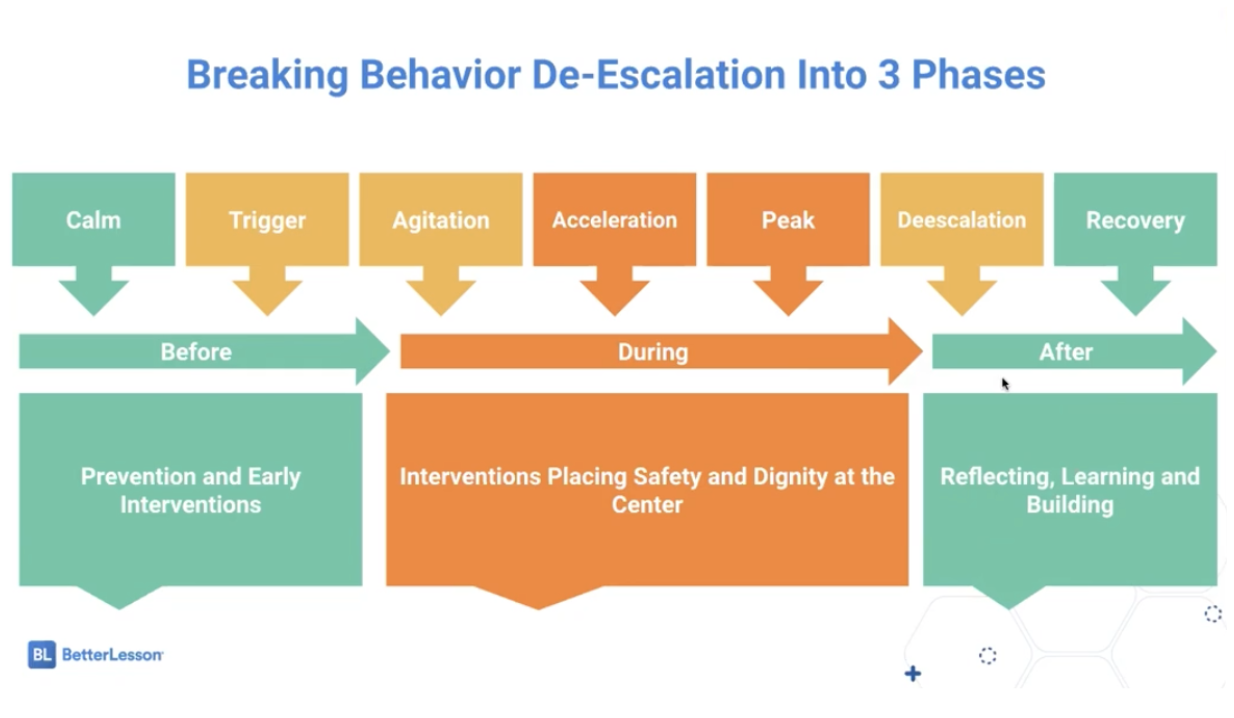
Before Escalation
During the calm and trigger phases, there is an opportunity for teachers to engage in proactive de-escalation: to minimize the triggers that can occur within the classroom. There are three key strategies to reduce the likelihood and severity of behavior escalation:
Set and Continuously Improve Clear Expectations
When expectations for student and teacher behavior are unclear, there is opportunity for misunderstanding, biases, and tension. If a teacher, for instance, instructs students to “be quiet” during independent reading time, but they really mean “be silent,” when a student is reprimanded for whispering – a behavior the student likely believed met the expectation – tension and distrust will grow.
Alternatively, when teachers set clear expectations with input from students, there are fewer opportunities for conflict. Moreover, clear expectations provide both students and teachers language for addressing behavioral issues without judgment.
Strategies for Setting Clear Expectations:
- Giving Students a Voice in Classroom Procedures
- Modeling and Repeated Practice of Expectations, Routines, and Procedures
Build Relationships Every Day in Varied Ways
Building relationships is a critical practice to minimize opportunities for conflict and behavior escalation. And, when issues inevitably occur, strong relationships allow teachers and students to move toward the recovery phase more easily. However, while teachers are repeatedly told to prioritize relationship-building, they are not often provided tools and strategies to engage in these practices.
Strategies to Build Relationships:
- 2×10: Building Positive Relationships with Students
- Getting to Know Your Students All Year to Personalize Instruction
- Charting Positive Strengths to Build Relationships
- Weekly Classroom Meal with Students to Build Relationships and Community
Focus On the Positive More Than You Think is Necessary
There is extraordinary power in the ways in which we communicate with students. If students receive attention and connection primarily through negative or corrective actions, those disruptive behaviors will likely grow. Conversely, when teachers make a conscious effort to focus on positive behaviors and interactions, those behaviors are reinforced.
Strategies for Positive Interactions:
During Escalation
While behavior escalation occurs, there are key intervention strategies to help reduce the severity of the behaviors and to support students in moving toward the recovery phase.
During the earlier phases of escalation, teachers can provide non-disruptive interventions to help prevent further escalation. This might look like whispering a corrective instruction or simply checking in with the student.
Despite these early interventions, continued escalation can still occur. As this happens, first and foremost, teachers need to prioritize safety for everyone. This might mean asking for additional staff support during a moment of behavior escalation or allowing the student to have a moment outside the classroom.
As teachers respond to students during escalation, it is necessary to maintain students’ dignity in order to focus on repair and relationship-building during the recovery phases. Here are ways teachers can connect with their empathy and maintain student dignity during a situation of crisis:
- Acknowledge students’ feelings.
- State the observable and don’t act out of assumptions.
- Actively listen to understand.
- Show that you believe them.
- Re-assure that the relationship will still be there on the other side.
Another important consideration during behavior escalation is the experience of peers observing the situation. Ultimately, as other students watch this crisis unfold, they are looking for specific outcomes: Can the teacher keep us safe? Can the teacher support a student in crisis while keeping dignity at the center? Can the teacher bring us back to learning? In this way, moments of behavior escalation can also be seen as opportunities for strengthening a classroom community to prioritize dignity, relationships, and safety.
Strategies for De-Escalation:
- De-Escalation: Intervening with Emotionally Escalated Students
- Tone of Voice Check
- Peace Corners: Self Advocating for a Safe Place
After De-Escalation
As the student enters the de-escalation phase, teachers must first take care of themselves before supporting the student. If the teacher is feeling overwhelmed and dysregulated by the experience, they can inadvertently re-trigger the student and harm the relationship. Instead, by prioritizing their own regulation – taking deep breaths, relaxing their body, etc. – they are modeling self-regulation and they can more readily support the student in their own recovery.
The next step is to create space and time for the student and teacher to reflect and identify ways to move forward together. This phase is critical, as it lays the groundwork for how to respond to any conflicts or crises that might occur in the future.
Strategies for De-Escalation and Recovery:
- De-Escalation Reflection
- Self-Regulation Strategies
- Collaborative Conversations for Behaviorally Challenging Students
BetterLesson Resources
Ultimately, behavior de-escalation is deeply tied to trauma-informed practices, which is just one of BetterLesson’s professional learning offerings. BetterLesson can partner with school districts to provide targeted, individualized support in building out school-wide trauma-informed practices, including de-escalation tactics and mindsets.
Schedule a call with us today to learn more about how we can offer personalized support, resources, and capacity to implement or improve de-escalation and trauma-informed practices at your school.
Get in Touch